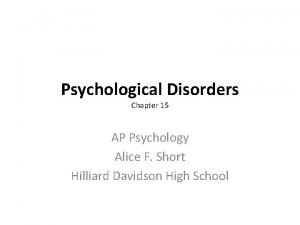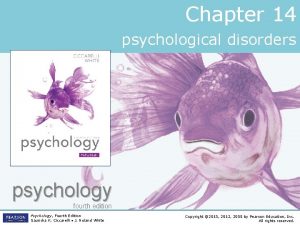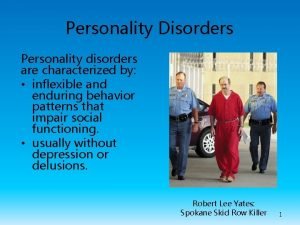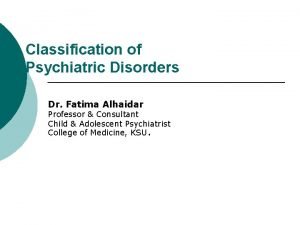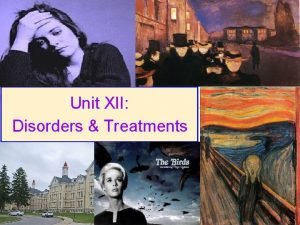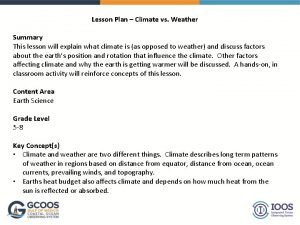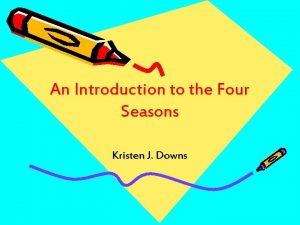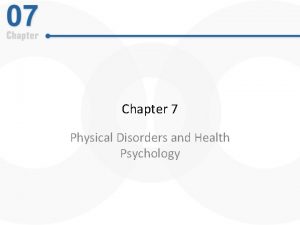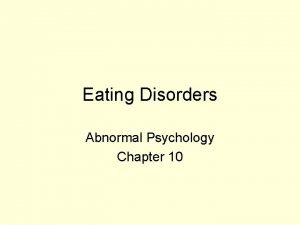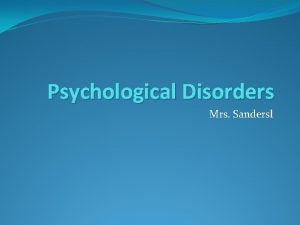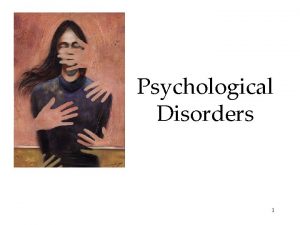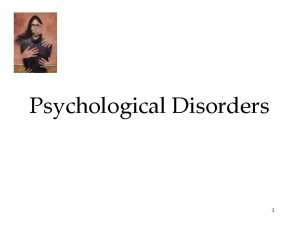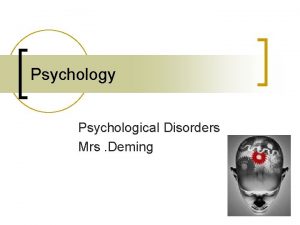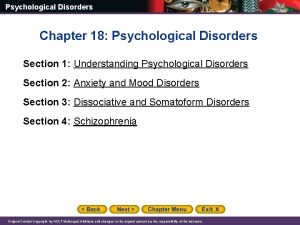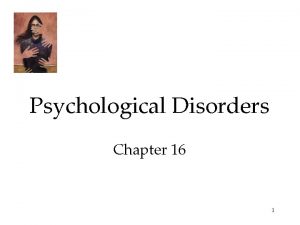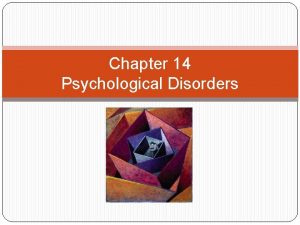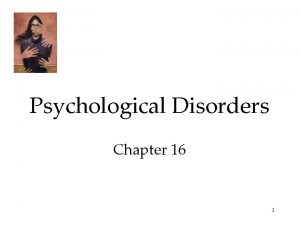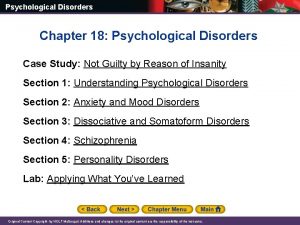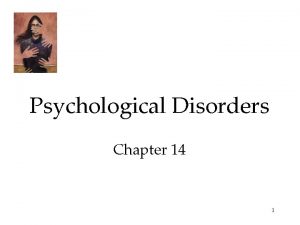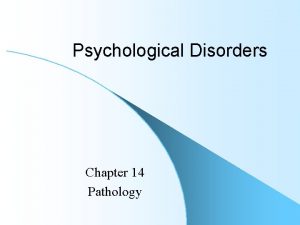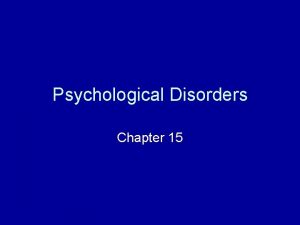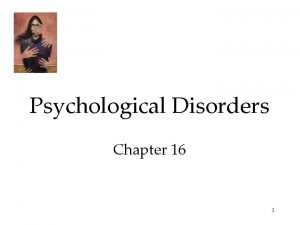Psychological Disorders Chapter 16 Psychology Fall Winter Psychological



















- Slides: 19

Psychological Disorders Chapter 16 Psychology Fall – Winter

Psychological Disorders • Where should we draw the line between normality and abnormality? • How should we define psychological disorders? • How should we understand disorders – as sicknesses that need to be diagnosed and cured or as natural responses to troubling environments?

Introducing Psychological Disorders • Con. Air: • • The English Patient: • • Major depressive disorder Primal Fear: • • Acute stress disorder As Good As It Gets: • • Antisocial personality disorder Dissociative identity disorder Copy Cat: • Panic disorder with agoraphobia

Disordered Behaviour • When is behaviour disordered? • According to many mental health workers psychological disorders are persistently harmful thoughts, feelings, and actions

Disordered Behaviour: 3 Components

Disordered Behaviour Deviant Disordered Behaviour: 3 Components (Abnormal) Distressful (disabling) Dysfunctional (Impairing)

Deviant Behaviour • Varies by culture and context: – • Examples: • Nude beaches • Paranormal psychologists (speaking with spirits) Standards continue to change – Homosexuality • – 1952 – 1973 homosexuality was considered an illness ADHD?

Understanding Psychological Disorders • A progression of understanding: – Throughout history there have been distinct approaches in dealing with psychological disorders

The Middle Ages • • Puzzling behaviour explained by: – Stars – Godlike powers – Evil spirits Remedy? – Caged – Given therapies appropriate to a demon: Beatings Burnings Castration Pulling teeth Removing intestines Blood transfusions

The Medical Model • • Philippe Pinel (1745 – 1826) – Opposed brutal treatment – Insisted behaviours were explained by sickness of the mind Pinel’s remedy – ‘moral treatment’: – Talking to patient – Replacing brutality with gentleness – Isolation with activity – Clean air and sunshine

The Medical Model (Cont’d) • The medical model assumption provided impetus for further reform • Hospitals replaced asylums • Medical perspective continues to hold water – Diagnosis, illness, symptoms, therapy, treatments, prescriptions

The Biopsychosocial Approach • • Contemporary Psychology: – All behaviour (disordered or not) comes from the interaction of nature and nurture – Not necessarily solely an internal problem Cultural-dependent issues: – Anorexia nervosa (Western cultures) – Susto (Latin America) – • The cause is a sudden frightening experience such as an accident, a fall, witnessing a relative's sudden death, or any other potentially dangerous event • Severe anxiety andrestlessness Taijin-kyofusho (Japan) • taijin kyofusho literally means the disorder (sho) of fear (kyofu) of interpersonal relations (taijin) • Avoids social contact

Classifying Psychological Disorders • • Intention of classifying disorder(s): – Describe – Predict American Psychiatric Association’s Diagnostic and Statistical Manual of Mental Disorders (fourth edition) – DSM - IV

DSM-IV • – Defines a diagnostic process and 16 clinical syndromes – Describes disorders – Lists prevalence – Seemingly very reliable Some believe it is too broad

Psychological Disorders: An Activity

Labeling Psychological Disorders • Major criticism – labeling is arbitrary “labels create preconceptions that guide our perceptions and our interpretations” – labels affect how we perceive people – Stereotypes linger – *Erroneous diagnosis may be self-confirming – clinicians may search for evidence in a client’s life history and hospital behaviour that is consistent with the diagnosis (activity)

Labeling Psychological Disorders • However, a ‘necessary evil’: – Allow for the communication of diagnosis – Comprehend underlying causes – Discern effective treatment programs – Allow for medical coverage

Portrayal of Disorders and the Media • Media’s role: – Sometimes offer reasonably accurate accounts (A Beautiful Mind ~ schizophrenia) – Often stereotype mental health patients as homicidal or freakish

The End
 Ap psychology chapter 15 psychological disorders
Ap psychology chapter 15 psychological disorders Medical model psychology
Medical model psychology Chapter 18 psychological disorders
Chapter 18 psychological disorders Chapter 14 psychological disorders
Chapter 14 psychological disorders Chapter 14 psychological disorders
Chapter 14 psychological disorders Inflexible personality
Inflexible personality Psychological disorders
Psychological disorders Bipolar
Bipolar Winter kommt winter kommt flocken fallen nieder
Winter kommt winter kommt flocken fallen nieder Winter kommt winter kommt flocken fallen nieder
Winter kommt winter kommt flocken fallen nieder Winter kommt winter kommt flocken fallen nieder
Winter kommt winter kommt flocken fallen nieder School bus
School bus Cast of spring, summer, fall, winter... and spring
Cast of spring, summer, fall, winter... and spring Winter spring summer fall poem
Winter spring summer fall poem How seasons work
How seasons work Parts of globe
Parts of globe Winter spring summer fall there are seasons four in all
Winter spring summer fall there are seasons four in all Fall winter summer spring
Fall winter summer spring Physical disorders and health psychology
Physical disorders and health psychology Eating disorders abnormal psychology
Eating disorders abnormal psychology
